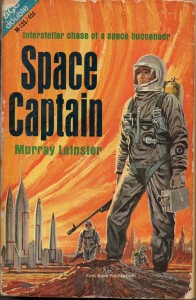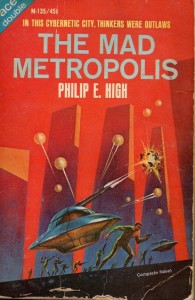Book Review: Space Captain by Murray Leinster/The Mad Metropolis by Philip E. High
This is another of the Ace Doubles–two short science fiction books in one volume, printed upside down from one another. In general, these are a good deal. A readable copy won’t set you back more than a brand new paperback in most used bookstores.
Space Captain is the story of Captain Trent, a starship captain from a line of captains that extends all the way back to when they sailed ships of wood on the oceans of Earth. Trent is hired to captain the Yarrow, a smallish cargo ship, into the Pleiads, a region of space so infested with pirates that even the pirates are complaining.
Faster than light travel is possible, but not FTL communication, and while in “overdrive” the only communication possible is detecting other overdrives. A more powerful drive can blow out a lesser one, and the pirates have the most powerful drives in the sector. Thus the situation is similar to the 17th Century age of piracy. However, the Yarrow has a new edge, a device created by its engineer that should blow out another ship’s overdrive regardless of how powerful it is, without endangering the ship it’s on.
In its first test, the device fails; but Trent’s superior captaining allows him to temporarily drive the pirates away from a passenger vessel. That vessel has aboard, among other things, the daughter of a planetary president. Trent puts in motion an elaborate scheme to both salvage the passenger ship and capture some of the pirates.
While Trent’s plan succeeds, the ruthlessness of the pirate gang soon complicates matters, and the space captain must track the outlaws to their lair–and will that blasted device ever work right?
This is not one of Mr. Leinster’s better works. Captain Trent is stoic and calculating, and somewhat awkward in social situations, and that’s about all the personality we see. He’s more an archetype of ship captain than an actual person. Most of the other characters come off similarly. McHinny the engineer is the most distinctive, being an obsessed, egotistical inventor.
Marian Hale is a pure damsel in distress type, and the entirety of the romantic subplot is Trent being attracted to her because…she’s the only woman in the story with a speaking part. She’s barely in the book.
The space as an ocean metaphor is overworked. One peculiar technology moment is needing to take photographs of the ship’s viewscreen with a separate camera, then make photocopies from those, rather than oh say using a screencap and sending it directly to the printer.
Overall, the action is dry, a series of events that follow one another.
The Mad Metropolis opens with ordinary laborer Stephen Cook being locked out of a bar at night. Which doesn’t sound so bad, except that in 24th Century Free City Two, being outside in the dark is a death sentence. “Psychos” haunt the streets looking for human prey, and the Nonpol patrols are scarcely more compassionate.
It soon becomes evident that Mr. Cook, is not as ordinary as he believes himself to be. For one thing, while he’s been operating at the mental level of a low-normal serf, Cook is actually a potential super-genius. And he has other qualities, as yet unknown, that make him a danger to the government’s plans, and thus the attempt to have him die in a “tragic accident.” Cook soon throws his lot in with the Oracles, one of the city’s factions, but even they do not know the full extent of the troubles to come.
Free City Two (formerly London) is an eerie place, where everything is disguised by hypnotic projections that fool all five senses (and even mechanical ones!) There’s a chilling scene where Cook forces himself to see what the city actually looks like, and how badly designed and dilapidated it truly is. And its society is just as rotten as its surroundings. Cook is shocked to his core about halfway through when he sees a human child for the first time.
The government has a plan; creating a global computer network that can assist them in keeping order. Turning it on, however, only creates more problems, as can be guessed by the fact that the main computer immediately dubs itself “Mother.” Mother soon has to deal with the erudite Oracles, the mercenary Nonpol, the criminal Syndicates, all of whom have their own ideas of what needs to be done.
Stephen Cook, of course, is the true key to the future, if he can figure out why those mental blocks were put in all those years ago. He makes a more interesting protagonist than Captain Trent, spending the first part of the story trying to survive against the odds, without the information that would explain why people want him dead. And even when he unlocks his full potential, Cook still has room to realize that he needs to change his path.
The supporting characters get moments in the spotlight, giving us a bit of their personalities and motivations even when Cook is not present. Jan Tremaine, a female Oracle, is the love interest, and even though the romance is perfunctory, it develops decently within the narrative, and she has her own personality.
The action is exciting, with a strong sense of danger. One interesting technology bit is the equivalent of the modern police car onboard computer that can access data from headquarters and vice-versa.
This isn’t the best Ace Double I’ve read, but has points of interest for the fan of older science fiction.



You do such a grand job of reviewing! You brought both books to life..drawing my interest….with just enough info, but not to much. In the immortal words of baby bear, “It was juusstt right”….LOL!
Always good to hear!